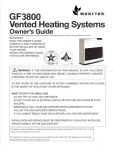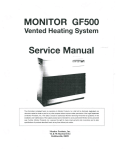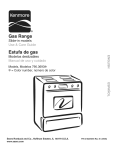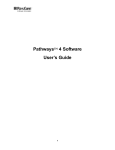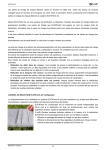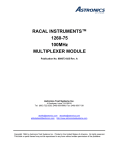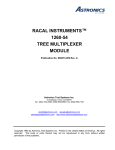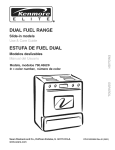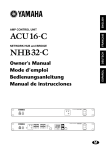Download Monitor GF 500 Service manual
Transcript
MONITOR GF200 Vented Heating System Service Manual GF 200 The information contained herein is proprietary to Monitor Products, Inc. shall not be disclosed, duplicated, nor otherwise copied in whole or part for any other purpose without express written permission of the Legal Department of Monitor Products, Inc. This data is issued to authorized Monitor Servicing Personnel for guidance in the installation and maintenance of the subject product and is intended for use by authorized Monitor service personnel only. Further, Monitor Products, Inc. reserves the right to make improvements and corrections and to alter specifications of products described herein, at any time without prior notice. P. O. BOX 3408 PRINCETON, NEW JERSEY 08543 MONITOR HEATING SYSTEM Table of Contents Section 1: Description 1-1 Specifications; 1-2 Special Features; 1-3 Safety Features; 1-4 Munual Gas Valve; 1-5 Automatic Gas Valve; 1-6 Gas Control Valve; 1-7 Burner; 1-8 Orifice; 1-9 Ignition Plug Unit; 1-10 Ignition Transformer; 1-11 Flame Detector; 1-12 Combustion Blower; 1-13 Heat Exchanger; 1-14 Flue Pipe; 1-15 Air Circulation Fan; 1-16 Air Pressure Switch; 1-17 Overheat Protector Switch; 1-18 Thermal Fuse; 1-19 Overcurrent Fuse; 1-20 Electrical System; 1-21 Microprocessor; 1-22 Temperature Sensor; 1-23 Safety Mechanisms; 1-24 Cloth Covered Exhaust Pipe; 1-25 Air Circulation Fan Guard; 1-26 Slide Selector For The Reset Temp. Page 1 - 7 Section 2: Installation 2-1 Notice Before Installation; 2-2 Heater Installation; 2-3 Flue Pipe Clearances; 2-4 Installing An Extension Kit; 2-5 Gas Connection; 2-6 Gas Conversion Procedure; 2-7 High Altitude Installation; Page 9 Section 3: Operation 3-1 Introduction; 3-2 Operating Specifications; 3-3 Operating Controls And Indicators; 3-4 Operation Control System Page 11 ^ Section 4: Maintenance/Servicing 4-1 Cleaning The Cabinet; 4-2 Checking The Flue Pipe; 4-3 Cleaning The Interior; 4-4 Cleaning The Blower Guard; 4-5 Electric Motor Maintenance; 4-6 Checking The Burner Flame; 4-7 Cleaning The Burner Pagel 3 Section 5: Troubleshooting Resistance Values Component Voltage Readings Page 15 -16 Section 6: Electrical System Schematic Wiring Diagram Page 17-18 MONITOR HEATING SYSTEM Section 1: Description 1-1 SPECIFICATIONS Model No. Type of Appliance Input Rating Output Rating Electrical Rating Power Consumption Heated Air Delivery Flue Pipe Hole Dimensions Weight Inlet Gas Supply Pressure Manifold Test Pressure GF 200 Fan type direct vent wall furnace High 20,000BTU/hour (Nat.), 20,000 BTU/hour (LP.) Low 12,60QBTU/hour(Nat.), 13,400 BTU/hour (LP.) High 16,OOOBTU/hour(Nat.), 16,000 BTU/hour (LP.) Low 10,200BTU/hour(Nat.), 10,900 BTU/hour (LP.) 120 V, 60 Hz, Less than 2 amperes 65 Watts High 176 Cubic feet/minute Low 113 Cubic feet/minute 2.5 inches diameter Height: 25.6 inches Width: 20.9 inches Depth: 12.4 inches 55 pounds Nat. Gas Max. 10.5 inch W.C. (267 mmH2O) Min. 5.1 inch W.C. (130 LP. Gas Max. 13.0 inch W C. (330 mmH2O) Min. 11.0 inch W C. (279 mmH2O) 3.15 inch W. c. (80 mmHzO) Nat . Gas LP. Gas 3.19 inch W (81 mmHaO) The minimum and maximum inlet gas supply pressures are for the purpose of input adjustment. 1-2 SPECIAL FEATURES 1-3 SAFETY FEATURES AUTOMATIC IGNITION MEMORY BACK UP: Set memory can be kept in case of power failure for up to 5 minutes. DUAL BLOWERS: Separate fans for combustion and room air circulation. THERMOSTATICALLY CONTROLLED: Adjusts to the desired room temperature. BUILT-IN TIMER: Heater will automatically operate as programmed by the user. AUTOMATIC RESET AFTER POWER FAILURE: Heater will automatically resume operation after power is restored. INDICATOR LIGHTS: Easy-to-see signals show when heater is in operation, when timer is activated, and when the burner is operating in low or high modes. SAFE RE-LIGHTING: Heater will not restart until its combustion chamber has cooled. ELECTRICAL PROTECTION: Heater automatically shuts off in the unlikely event of a malfunction in the electrical circuitry or disruption of the power supply. NO EXHAUST IN ROOM: Products of combustion are discharged outdoors. FLUE PIPE: Outside air is drawn through a pipewithin-a-pipe venting system. This process preheats combustion air and regains heat from exhaust gases. CLEAN OPERATION: Products of combustion are vented outside. CONSUMES NO ROOM AIR: Air for combustion is drawn from outside. EASY INSTALLATION: Includes all parts required for standard installation A CAUTION: ALTERNATE POWER SOURCES The Monitor GF200 may not operate when powered by sources such as an auxiliary generator, UPS (Uninterrupted Power Source), inverters, etc. This unit may not operate on a GFI (Ground Fault Interrupter) power circuit. Check with your dealer for guidance on specific applications. MONITOR HEATING SYSTEM Section 1: Description 1-4 MANUAL GAS VALVE The Manual Gas Valve is included with Heater. Connect the Manual Gas Valve to gas inlet at rear of the cabinet. Connection must be checked for gas-tightness by means of leak detector solution, soap and water, or an equivalent nonflammable solution, as applicable. 1-6 GAS CONTROL VALVE The Gas Control Valve provides constant gas pressure (volume) of two modes (High, Low) to the burner. Operation of the Gas Control Valve is controlled by the Microprocessor. The specifications of the Gas Control Valve are as follows: Type of gas Natural Inlet Gas Supply 7.0 Pressure (in W.C.) Manifold 3.15 1.34 Pressure (in W.C.) Burn Mode High Low LP 11.0 3.19 1.42 High Low Adjusting Screw Figure 1 -1 1-5 AUTOMATIC GAS VALVE The Automatic Gas Valve is a normally closed two-stage, electro/mechanical device which either allows gas to flow to the burner or prevents it from doing so. When the valve is energized, a spring-loaded plunger is lifted to permit the flow of gas. Removing power from the valve drops the plunger down into the inlet to prevent gas from passing through. Diaphragm Body Figure 1 -2 Coil Manifold pressure can be cheked by removing brass fitting from end of Gas Control Valve and inserting a guage with 1/8 NPT fitting. Spring Body Valve Figure 1 -3 MONITOR HEATING SYSTEM Section 1: Description 1-7 BURNER This burner is a Bunsen type with a specially structured flame port section, which shapes and positions the flame, so it can be wrapped by the secondary air flow, and burn completely. Secondary Air Flame Port Section Primary Air and Gas Mixture Burner Chamber Burner Port Assy Burner Assy Secondary Air Mixing Plate Orifice 1-8 ORIFICE The orifice is made of brass, inserted into the gas passage of the mixer, and fixed by the gas pipe. NOTE: For altitude applications over 2,000 feet refer to page 9. /!\ WARNING: Use of incorrect orifice will create a fire hazard and damage unit. Gas Type Shape, Stamp Orifice size LP Natural (| t— Figure 1 -4 1 Dia 2.38mm 1 Q_ -J Dia 1.87mm MONITOR HEATING SYSTEM Section 1: Description 1-9 IGNITION PLUG UNIT The Electrode is applied high voltage, and discharges to the Grounding Rod to ignite the burner. The discharge gap between the Electrode and the Grounding Rod is 3.5 ± 0.8 mm. Flame Detector Rod Electrode Grounding Rod Figure 1-6 1-10 IGNITION TRANSFORMER The Ignition transformer generates high voltage using 120 VAC power, discharged by the Ignition plug to ignite the burner. 120VAC Power Terminal High Tension Cord Grounding Terminal Figure 1 -7 /!\ WARNING: Do not touch when functioning. High voltage of 15 kV is generated. MONITOR HEATING SYSTEM Section 1: Description 1-11 FLAME DETECTOR An Electrode which detects that the burner has been ignited, using the flame as a conductor, instantaneously detects when the flame extinguishes and shuts down the Automatic Valve. 1-12 COMBUSTION BLOWER The Combustion Blower has a two stage intake fan. The intake fan draws in outside air thru the flue pipe for internal combustion. Burner modes control fan speeds and the Solenoid Damper in the Blower Casing. Those functions are as follows: COMBUSTION AIR CONTROL Burn Mode Fan Speed Solenoid Damper High High Off (open) Low Low On (close) Setting air flow for Solenoid Damper on Low mode should read 5.5±0.5mmHzO for Nat. and 5.5±0.5mmH2O for LP. 1-13 HEAT EXCHANGER An inlet at the top of the Heat Exchanger permits the heated air to travel from the Combustion Chamber into the Heat Exchanger. An outlet, at the bottom of the Heat Exchanger, permits combustion by-products to be vented to the Flue Pipe. While moving through the Heat Exchanger, the hot air within the Heat Exchanger heats the outside metal walls. The hot metal walls, in turn, heat air that is pushed past the Heat Exchanger and is circulated into the room. An air baffle, directly in front of the Heat Exchanger, deflects the heated air downwards, and out, through the Louver assembly. 1-14 FLUE PIPE Flue Pipes are available in three (3) sizes. This provides the flexibility to meet the installation requirements for dwelling of various wall thicknesses. One side of the Flue Pipe contains a "T"-shaped fitting consisting of four ports. This side is mounted on the interior wall of the dwelling. The pipe side of the Flue Pipe is vented outside the dwelling. The Flue Pipe assembly consists of two concentric tubes. Outside air is drawn through the cylindrical space between the tubes. As the cool air enters, it is heated by the hot air that is exiting the system. A large-bore, flexible hose connects the air inlet port on the Flue Pipe with the Combustion Blower; a cloth-covered metal pipe connects the Heat Exchanger with the exhaust outlet on the Flue Pipe. 1-15 AIR CIRCULATION FAN The Circulation Fan is driven by a two speed motor and is designed to circulate the heated room air. If the heater is running in low burn mode, the fan also runs at low-speed; in high burn mode, the fan advances to high-speed. Operation of the fan is controlled by the Microprocessor and Fan Thermostat Switch. Physically assembled with a protective wire cage, the entire fan assembly is secured to a bracket on the rear of the Heater Cabinet. A sheet metal conduit, at the rear of the Heater, protects the fan wiring from damage. MONITOR HEATING SYSTEM Section 1: Description 1-16 AIR PRESSURE SWITCH This switch consists of a rubber diaphragm which senses changes in air pressure (it is connected to the Combustion Blower and the Combustion Chamber) and a normally-open, micro switch. Should an abnormal pressure differential exist, the switch opens to disable the circuitry that controls the supply of gas. Since the flow of gas to the Burner is cut off, the flame extinguishes, and the burner Status Indicators blink. This safety mechanism can be triggered by several conditions: - Leak, loose, or broken tubing which connects the Air Pressure Switch with the Combustion Blower or the Combustion Chamber - Clogged or blocked Air Line - Blocked or clogged Flue Pipe -Intake port of the Combustion Blower is blocked - Combustion Blower is inoperable Electrical operation of the Monitor can be thought of as having the following eight(8) distinct phases: plug in; turn on; pre-purge; ignition; precombustion; heating; shutdown and post-purge. 1-21 MICROPROCESSOR Principally consisting of a 64-pin Integrated Circuit, the Microprocessor provides safety timings, controls relays and provides clock and thermostat functions for the Monitor heater. 1-22 TEMPERATURE SENSOR The sensor which is capable of sensing room temperature within a range of 42°F to 96°F, can be left mounted on the back of the heater cabinet or be wall mounted. Approximately 61/2' (about 200 cm) of No. 20 AWG Wire is supplied with the sensor to facilitate wall mounting the sensor in a favorable location. 1-17 OVERHEAT PROTECTOR SWITCH The normally-closed Overheat Protector Switch safeguards the heaters against damage due to overheating. The Switch is rated 110°C (230° F). Should a Monitor overheat (internal temperatures rise beyond 110°C/230°F) the switch will open to shut down the heater. After extinguishing the flame, the Burner Status indicators continue to blink. The Overheat Protector Switch will automatically reset after cooling down. Once the heater has cooled to 90°C(194°F), the system can be restarted. To restart the Monitor, proceed as follows: A. Press ON/OFF Switch to OFF. B. Allow heater to cool. C. Troubleshoot the cause of the overheat. D. Press ON/OFF switch to ON. E. Proceed with normal operation. I-23 SAFETY MECHANISMS Several safety mechanisms have been built into the Monitor Heating System. These devices protect the user against personal injury, protect the heater against damage, and shutdown the heater if a malfunction occurs. 1-18 THERMAL FUSE Should the Overheat Protector Switch malfunction, and the heater be further overheated, the thermal fuse(internal temperatures rise beyond 167 3 C/333°F) melts and prevent further overheating. 1-25 AIR CIRCULATION FAN GUARD This guard is an integral part of the fan assembly. The guard protects the user against physical injury which could occur from accidental contact with revolving metal fan blade. 1-19 OVERCURRENT FUSE 2-amp., 125VAC, fuse protects the heater from damage resulting from power overloads. In the event of a power surge or internal wiring hazards, the fuse opens and power to the heater is cut off. 1 -26 SLIDE SELECTOR FOR THE RESET TEMP. Once power is restored after power interruption by power failure or by disconnecting heater plug from wall outlet, heater will resume operation in the MANUAL mode and maintain room temperature according to the setting temperature selected by using the selector for the reset temperature at the lower right hand side of the cabinet. 1-20 ELECTRICAL SYSTEM Electrical power is supplied to the Monitor to run the Microprocessor and the other electricallyenergized component. 1-24 CLOTH COVERED EXHAUST PIPE Insulating cloth covers are to be placed over all metal surfaces of the Exhaust Line during installation. Since combustion by-products are vented at elevated temperatures, the Exhaust Pipe will become hot during operation. The insulating cloth covers protect the user from burn hazards associated with accidental contact with these heated metal surfaces. During installation make sure that all Exhaust Lines are tight. Do not operate the heater without the insulating covers. MONITOR HEATING SYSTEM Section 1: Description LU CO in z o CO ID CQ 5 O o LU o CO LU LU cp 1 O) ^ MONITOR HEATING SYSTEM Section 2: Installation 2-1 NOTICE BEFORE INSTALLATION After check, reinstall fitting and check for leaks. Refer to the service manual of the Monitor GF500 2-7 HIGH ALTITUDE INSTALLATION Refer to the service manual of the Monitor GF500 All Units must be installed according to the following chart to determine which orifice will be used for the appropriate altitude. NOTE.-Use the cardboard template provided with the Heater for flue pipe location. Just in case the template was misplaced, the approximate flue pipe hole location measurements are follows: NATURAL GAS UP TO 2000 feet No changing orifice(2.38mm) 2000-6000 feet 2.28 mm drill size orifice 2-2 HEATER INSTALLATION The center of the Joint Pipe opening, which connects to the Flue Pipe. Back of Healer LP GAS UP TO 2000 feet No changing orifice(1.87mm) 2000-6000 feet 1.78 mm drill size orifice </I\ WARNING: Do not use above 6000 feet. Fuel Inlet 2-3 FLUE PIPE CLEARANCES Refer to the service manual of the Monitor GF500 2-4 INSTALLING AN EXTENSION KIT Refer to the service manual of the Monitor GF500 2-5 GAS CONNECTION Refer to the service manual of the Monitor GF500 2-6 GAS CONVERSION PROCEDURE 1. Replace the natural orifice with the LP orifice which is included in the conversion kit. Check orifice fitting for gas leak •Slide the gas type selector on PCB to the LP position. •Check that the manifold pressure matches the following values. If not adjust them -to the following values using volume resister(VR1:Hi VR2:Lo)on the PCB. Hi:3.19"-S 2 5 W.C. Lo:1.42"-g- 16 W.C. MONITOR HEATING SYSTEM Section 3: Operation 3-1 3-2 OPERATING SPECIFICATIONS INTRODUCTION Monitor is an easy-to-operate vented gas heater. Routine operation features high BTU output, automatic adjustment of room temperature, low power consumption, and choice of automatic or manual heater operation. This section provides all information necessary to operate the Monitor Heating System. All operation procedures specified should be performed in the order in which they are described. The following specifications apply to the operation of the Monitor GF 200. - Rated Efficiency: 81 % - Power Consumption: as follows High Bum 65 watts, Low Burn 65 watts - Circulation Fan Output: 176 cubic feet/min - Potential Heating Area: 600 - 1200 sq. feet 3-3 OPERATING CONTROLS AND INDICATORS Several controls and indicators are used to operate the heater and to monitor its performance as follows: RUN AUTO EC °LN°SMY BURNER STATUS Figure 3-1, INDICATORS 11 12 13 14 15 OPERATION ON/OFF 21 AUTO 22 ECONOMY PLUS iTIMfeR | TIN SELECTOR CLOCK | , S T st 2 nd 3Vd 4th 16 TIME/TEMP SET TIME | ' I 10 23 | HOUR MINUTE SET CLEAR 17 Figure 3-2, CONTROLS NOTE: Refer to the service manual of the monitor GF500 in detail 3-4 OPERATION CONTROL SYSTEM Refer to the service manual of the monitor GF500 11 18 19 20 MONITOR HEATING SYSTEM Section 4: Maintenance / Servicing 4-1 CLEANING THE CABINET Refer to the service manual of the Monitor GF500 4-2 CHECKING THE FLUE PIPE Refer to the service manual of the Monitor GF500 4-3 CLEANING THE INTERIOR Refer to the service manual of the Monitor GF500 4-4 CLEANING THE BLOWER GUARD Refer to the service manual of the Monitor GF500 4-5 ELECTRIC MOTOR MAINTENANCE Refer to the service manual of the Monitor GF500 4-6 CHECKING THE BURNER FLAME Refer to the service manual of the Monitor GF500 4-7 CLEANING THE BURNER Refer to the service manual of the Monitor GF500 13 MONITOR HEATING SYSTEM Section 5: Troubleshooting GF200 Resistance Values APPROX. OHMS COMPONENT Ignition Transformer (connector E/E) 108,000 Power Transformer (1)-Primary (AC 120V) 66 Power Transformer (l)-Secondary (AC 11V) 1.6 Power Transformer (l)-Secondary (AC 120V) 647 Power Transformer (2)-Primary (AC 120V) 66 Power Transformer (2)-Secondary (AC 22V) 6.4 Damper Solenoid (connector I/I) 4,600 Resistor (connector G/G) 68 Circulation Fan (R & BK) 235 Circulation Fan (BK & Y) 247.5 Combustion Blower (BK & BK) 18 Thermistor (connector Q/Q at 77°F) 10,000 Fuse 2A (read with fuse out) 0.1 Gas Control Valve (connector P/P) 87 Gas Solenoid Valve (connector UL) 2,400 Gas Solenoid Valve (connector M/M) 2,400 WARNING: DISCONNECT HEATER FROM POWER SOURCE BEFORE MAKING ANY RESISTANCE TESTS. NOTE: Refer to the service manual of the monitor GF500 in detail. 15 MONITOR HEATING SYSTEM Section 5: Troubleshooting GF 200 Component Voltage Readings COMPONENT READING TAKEN AT Thermistor Q on PCB Sensor Disconnected Thermistor AC DC 5 All readings taken with components connected to PCB. Q on PCB Sensor connected 1.5 - 3.2 Air Pressure Switch/ Overheat Protector Closed J on PCB 0 Air Pressure Switch/ Overheat Protector Open J on PCB 110 Damper Solenoid I on PCB 105 Gas Control Valve High mode P on PCB 8.7 Gas Control Valve Low mode P on PCB 6.2 Circulation Fan High Speed R to BK 110 Circulation Fan Low Speed R to BK 93 Ignition Transformer E on PCB 110 Power Transformer (1) (primary side) AC 120V 110 Power Transformer (1) (secondary side) AC 11V AC 120V 11 120 Power Transformer (2) (primary side) AC 120V 110 Power Transformer (2) (secondary side) AC 22V Combustion Blower High Speed F on PCB Combustion Blower Low Speed F on PCB (Q1 is off) 88 Resistor G on PCB 22 Gas Solenoid Valve L on PCB 105 Gas Solenoid Valve M on PCB 105 22 110 16 ' MONITOR HEATING SYSTEM Secction 6: Electrical System 17 1. Unless otherwise specified, unit of capacitor should be yuF and unit of resistor should be Q. 2. Unless otherwise specified, diode should be cat. NO. 1S2076A and resistor should be J type 1/4W or 1/8W. MONITOR HEATING SYSTEM Section 6: Electrical System WIRING DIAGRAM CAUTION: • Label all wires prior to disconnection when servicing controls. Wiring errors can cause improper and dangerous operation. Verify proper operation after servicing. • If any of the original wire as supplied with the appliance must be replaced, it must be replaced with a wire of at least a 105°C temperature rating. GAS CONTROL VALVE CODE Bk Bl Br G Or R W Y Gr RESET TEMP SELECTOR TF COLOR Black Blue Brown Gray Orange Red White Yellow Green OHT BLOCK DIAGRAM RESET TEMP SELECTOR MARK BM ER F FM FR FT OHT PS RC1-4 R1~4 SL SP SV1 SV2 TA1-4 TF TH TR1 TR2 PARTS NAME COMBUSTION BLOWER MOTOR ELECTRODE CURRENT FUSE CIRCULATION FAN MOTOR FLAME ROD FAN THERMOSTAT OVERHEAT THERMOSTAT AIR PRESSURE SWITCH RECTIFICATION CIRCUIT RELAY SOLENOID SPARKER SOLENOID VALVE 1 SOLENOID VALVE 2 TRIAC THERMAL FUSE THERMISTOR TRANSFORMER 1 TRANSFORMER 2 •3C- Grounded inside chassis at bottom of unit. GAS CONTROL VALVE 18 MONITOR HEATING SYSTEM Parts List NO. PARTS NAME REMARKS NO. PARTS NO QTY 1 ADJUSTABLE LEG 5019 4 33 PARTS NAME PRESSURE DETECTIVE PIPE PARTS NO. QTY 6820 1 2 TRAY 6800 1 34 BURNER ASSY 6821 1 3 AIR SUPPLY HOSE A 6101 1 35 MIXING PLATE ASSY 6822 1 4 AIR SUPPLY HOSE B 6102 1 36 BURNER PORT ASSY 6823 1 5 ORING(PIO) 6604 1 37 FLAME HOLDER 6824 1 6 AUTOMATIC GAS VALVE UNIT 6801 1 38 BURNER PACKING 6825 1 7 GAS PIPE ASSY 6802 1 39 ORIFICE HOLDER 6826 1 8 GAS INLET JOINT 6803 1 40 ORIFICE GUIDE 6643 1 1 9 ORING(P11) 6609 1 41 GASKET 7 6827 10 GAS PIPE JOINT 6804 1 42 BLOWER ASSY 6828 1 11 0 RING (P14) 6805 1 43 BLOWER MOTOR 6829 1 12 MANUAL GAS VALVE 6601 1 44 SOLENOID 6142 1 13 GASKET 1 6806 1 45 SUCTION CASE A 6143 1 14 BURNER CHAMBER ASSY 6807 1 46 SEAL PACKING 6144 1 15 WINDOW PACKING 6616 1 47 PWB SPACER CLIP A 6461 2 16 MICA PLATE 6617 1 48 PWB SPACER CLIP B 6462 14 17 MICA HOLDER 6618 1 49 PWB ASSY 6830 1 18 PLUG BASE ASSY 6808 1 50 CABINET ASSY 6831 1 FLAME DETECTIVE PLUG ASSY 6809 1 51 RUBBER BUSH 6136 2 18-1 18-2 IGNITION ELECTRODE ASSY 6810 1 52 CORD BUSHING 6833 1 18-3 PLUG HOLDER 6622 1 53 POWER SUPPLY CORD 6648 1 18-4 PLUG PACKING 6623 1 54 CARRYING HANDLE 6138 2 19 GASKET 5 6811 1 55 SENSOR ASSY 6186 1 20 GASKET 6 6812 1 56 SLIDE SWITCH ASSY 6649 1 21 COMBUSTION CHAMBER ASSY 6813 1 57 SLIDE SWITCH PANEL 6207 1 22 ORIFICE (NAT GAS) 6814 1 58 KNOB 6208 1 23 ORIFICE (LP GAS) 6815 1 59 WIRING GUARD 6263 1 24 GASKET 4 6120 1 60 FAN BLADE 6180 1 25 HEAT EXCHANGER ASSY 6816 1 61 CIRCULATION MOTOR 6262 1 26 GASKET 6 6122 1 62 BLOWER GUARD ASSY 6261 1 . 27 EXHAUST DUCT ASSY 6630 1 63 UNDER COVER 6832 1 28 0 RING (P39) 6176 1 64 LOUVER ASSY 6210 1 29 GASKET 2 6817 1 65 FRONT COVER 6833 1 30 AIR PRESSURE SWITCH 6818 1 66 LAMP PANEL 6834 1 31 AIR LINE 6819 1 67 SWITCH & LAMP ASSY 6835 1 32 SPARKER 6634 1 68 FAN THERMOSTAT 6152 1 REMARKS NOTE : TO OBTAIN PARTS, CONTACT YOUR DEALER OR, MONITOR PRODUCTS, INC. P.O. BOX 3408, PRINCETON, NEW JERSEY 08543 19 MONITOR HEATING SYSTEM Parts List NO PARTS NAME PARTS NO. QTY OVERHEAT THERMOSTAT 6463 1 70 THERMAL FUSE 6836 1 71 TOP COVER 6837 1 72 WALL CLAMP 6194 2 69 73 VENT CONNECTOR 4004 1 74 PIPE HOLDER 4006 1 75 AIR SUPPLY HOSE ASSY 6145 1 76 FLUE PIPE ASSY 6841 1 77 SCREW CAP ASSY 6148 1 78 OUTSIDE FLANGE 6148 1 79 OUTSIDE PACKING 6148 1 80 EXHAUST OUTLET CAP 4014 1 81 AIR PORTO RING 4016 1 82 AIR OUTLET CAP 4805 1 83 HOSE BAND 4008 2 84 AIR DAMPER 6839 1 85 OWNER'S GUIDE 6840 1 86 ORIFICE(2~6000FT LP) 6844 1 87 ORIFICE( 2 -600OFT NAT) 6843 1 88 TRANSFORMER-2 6663 1 89 AIR LINE B 6845 1 90 POWER TRANSFORMER 6251 1 REMARKS NO. PARTS NAME PARTS NO. QTY REMARKS NOTE : TO OBTAIN PARTS, CONTACT YOUR DEALER OR. MONITOR PRODUCTS, INC. P.O. BOX 3408, PRINCETON, NEW JERSEY 08543 20 MONITOR HEATING SYSTEM Exploded Views and Parts List ^ 21 MONITOR HEATING SYSTEM Exploded Views and Parts List 22






















